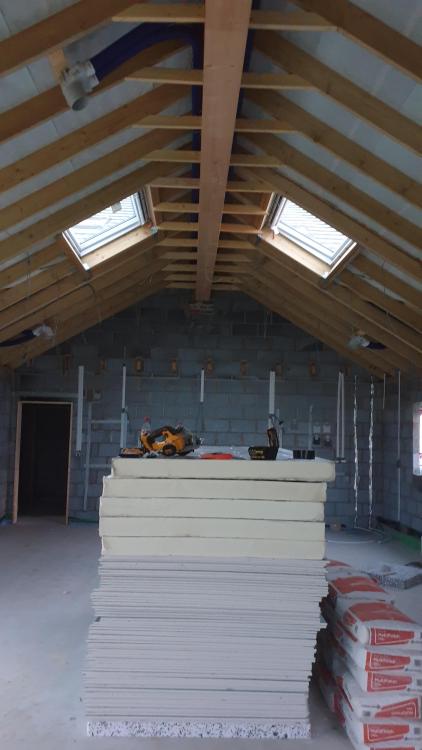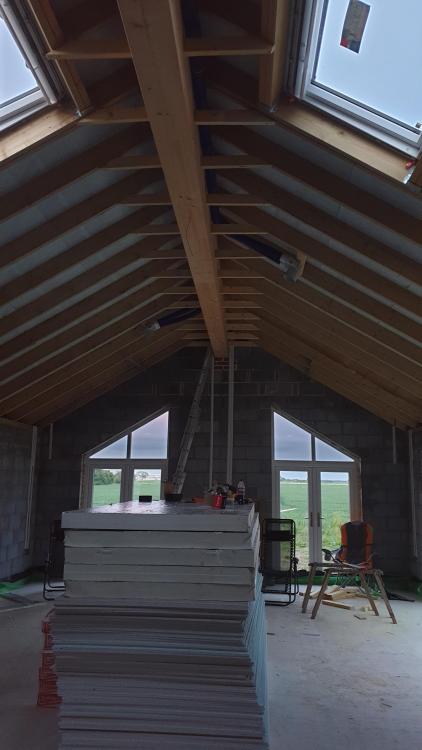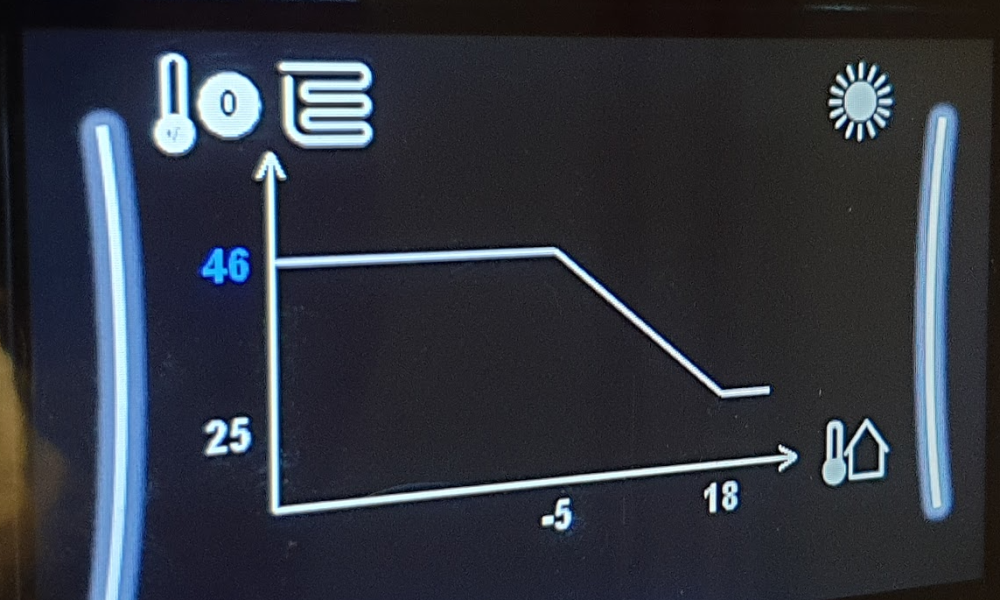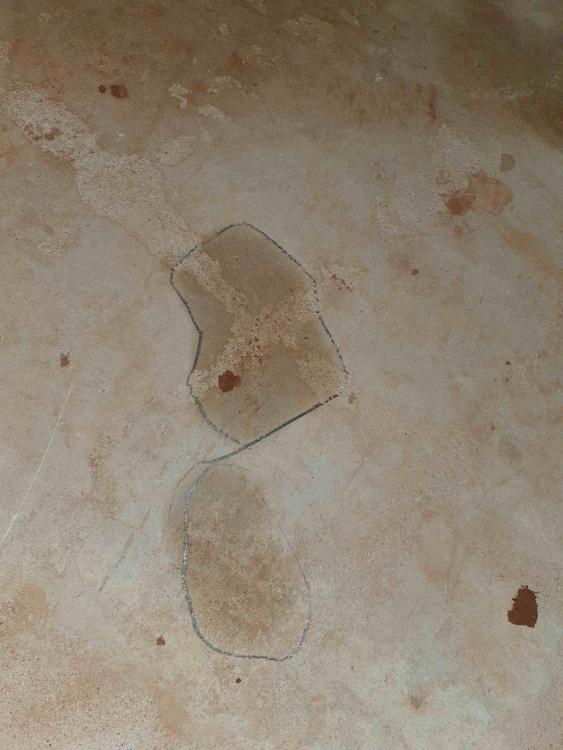Leaderboard
Popular Content
Showing content with the highest reputation on 12/12/22 in all areas
-
2 points
-
You are correct. Tell them '.... I am a Domestic Client under CDM 2015.... Please tell me the name and contact details of your line manage so I can submit a complaint about your interference on a private site....' And then a cheerful Prestonian Bye Bye....2 points
-
I used this one also, have to say it is very good. On 10 degree days, it does say you need more heat that you actually do, but doesn't account for people or solar gain. However the last 24 hrs, with an average temp at about -6 and no solar gain, almost to the kWh over 24 hrs correct. Can't ask for better than that.2 points
-
Most of the heat pumps those guys use have curve shift etc built into the heat pump controls. (i.e. you can offset the entire weather comp curve up or down to effect night setback or holiday setback) They also have load comp too mind. TRVs as limit stops is more for bedrooms outside the main zone.1 point
-
Not bad for -3degC outside in a 190sqm property at 20degC inside. My old self build of 130sqm has about the same power draw so you are doing around 50% better than me! You'll get a better result by setting back a couple of degrees at night then running a bit higher during the day when outside temps are maybe 6degC warmer at the moment and the heat pump runs more efficiently with little or no defrosting. I go 18 night, 20 day1 point
-
Put plastic over them - if there is a drip from above the plastic will catch it1 point
-
Yes run the flow temperature at the lowest that will deliver enough heat into the house. What is the temperature at the UFH blending valve set to?1 point
-
1 point
-
Right, there are a few of things. Is it a new build, if so, may still be drying out. How high is the flow temperature and do you keep the heating in permanently? Power is kW, kWh is energy, it is energy you pay for, not power. Do you use a lot of hot water, how hot is it stored at. How well insulated is your house, floor included? How does it match your heat loss calculations? It is 7⁰C down here on Penzance Promenade.1 point
-
1 point
-
1 point
-
I thought my UFH design was pretty good. But now that I've lived through a couple of cold weeks, I've spotted an incorrigible flaw which I thought I'd write about here so others can avoid making it. Our ground floor consists of the following zones: Fairly wide entrance hallway with a WC under the stairs Front room kitchen and utility room open plan lounge area off kitchen I thought that was plenty of zones. Turns out I was wrong. The WC is in the middle of the ground floor, with the hallway and utility room to one side of it, the front room on the other side and the lounge behind it. Accordingly, although it's just made out of stud walls, being in the centre of the floorplan, it has no external walls and so probably doesn't lose much heat. The WC gets significantly warmer than the rest of the floor. Setting the thermostat on the zone (which is located in the porch on an external (brand new cavity wall) to 20C, gets the general area to about 20.5C but the WC to 22.7C. I think it's mainly because of the lack of external walls/windows, but there's possibly other factors I'm not aware of. So I guess the lesson is if you have a space which has the unique characteristics that my WC room has, consider putting it on its own zone.1 point
-
I'll hazard a guess that this has been skimmed over artex. Depending how old the property is, regardless of asbestos survey already done, a small sample of this will need testing, they wouldn't have been able to test what they can't see1 point
-
That reminds me of a job we were doing in Milton Keynes, first day crane on site the local HSE guy came to tell us he passed this site twice a day. Needless to say everyone told to be squeaky clean. One day he came onto site and the bell was ringing on the crane (kato truck cranes all did this whenever boom was below 30 degrees) but instead of telling the guy this, crane driver said “please don’t phone my gaffer” and why is that? Because he’s always told me to turn the bell off if I’m doing anything dodgy! 🙈 let’s just say we didn’t get much done over the next few days1 point
-
The problem having one space colder than the rest of the house is that it will attract condensation as the air in the warmer spaces will host a greater amount of water vapour. This will degrade the fabric and anything you store in the space, therefore I would ensure that there was a mains outlet under the stairs and invest in a desiccant style de-humidifier with a drain hose for unattended operation (with a drain exit from the space). Desiccant because they are effective in unheated spaces (unlike refrigerated types of dehumidifier) and the small amount of electrical power used to recharge the desiccant provides a tiny bit of warmth.1 point
-
Did you tell them you we're practicing for the winter Olympics and there are no other ski slopes locally?1 point
-
Not a specific one but.... http://eec.co.uk/ https://www.environ.co.uk/ https://caice.co.uk/ https://www.soundplanning.co.uk/acoustic-enclosures/ https://acousticenclosuresltd.co.uk/1 point
-
People need to be told that during primary school science lessons. If 8 year olds cannot be taught how reducing a flow temperature, or a flow rate, will reduce energy transfer, then school teachers need a kicking, not a (expletive deleted)ing pay rise. This reply was partly prompted by two women in the cafe talking about increasing the boiler temperature in their homes because, and this is their words 'it saves money', 'that but on the news was bollocks'.1 point
-
Hi David, Dropped you a quick message but here is my introduction which will help answer that question.1 point
-
It's difficult to tell exactly where the problem is right now. Get an EPC assessment, they don't cost much, or very diligently work out your heat loss using one of the many online tools - others on this forum can recommend the best ones. That will tell you whether or not your HP power rating is adequate. Is it in good working order/have you had it checked/serviced? If it's working well and you can't improve insulation/air tightness any further, have you been warm enough for 95+% of the year? If so you may be better off just using some form of supplementary heating eg electric radiators to get you through the extra cold times.1 point
-
"Unfortunately we’re unable to suggest that you reduce your boiler flow temperature if you have a water tank. Our guidance doesn’t currently cover central heating systems that have a hot water tank. " Shame to put people off unnecessarily, many condensing heat-only boilers (if not most judging from my experience with a few different ones I've checked recently) are set to around 80oC The label on my own glow worm installed in 2008 perpetuates the old pre-condensing regime... ...by showing an example flow setting of 82oC. I'm pretty sure plenty of people would take this as advice when contemplating what the setting should be. Yet without any additional instruction, people with HW cylinders could be told to set the cylinder stat to 60oC and the boiler to 70oC and gain a bit of extra efficiency. The additional instruction would be that if they have a control system that provides independent HW and CH flow temperatures then take the extra step of reducing the CH in steps of 5oC until the system seems to take too long to heat the house. It does seem that they're trying to keep it dumbed down a bit too much to me. I mean, things are pretty serious at the moment. People need to apply themselves.1 point
-
I think cold weather is probably the best time to try and set the weather compensation. I'm playing about with ours now. It's -7°C here and I have the Thermostat set to 23°C to act almost as a limiter and the weather compensation is set as below. It could be that the flow temp is a bit high so I'll bring it down over the next few days, depending on how it performs. Currently the house is at 22°C and I've burned 1KWh on heating since midnight. If I had a log burner it would be going when it's this cold for sure.1 point
-
My heatpump runs at 35-38 degrees normally, these last few days I upped it to 45 as 38 didnt give us enough heat for the rads (upstairs) but 38 was still plenty for the UFH. I turned off weather compensation as my lowest water heating flow temp is 35 degrees, which is fine all the time the outside air temp is above 0. But when it drops below, It takes me 10 seconds to increase it from my phone so more efficient to leave it off and run at the lowest flow temp I can.1 point
-
Yes they need to be or you can get condensation from them especially when then outside temps are below zero. It only needs to be a thin insulation - I saw it done very successfully with the bubblewrap type stuff with aluminium tape over the joints. Can get it in self adhesive too https://www.toolstation.com/search?q=bubble+insulation1 point
-
1 point
-
It's very easy to install Celotex wrong. How you cut, i.e how square can have a major impact in how tight it fits against the joist. One way of near guaranteeing at least one side is tight to the joist is to cut 5mm under width. Hold in place with some nails then gun foam the hell out of the gap.1 point
-
Good idea. The ceiling underneath is a mess and has to come down anyway. I wonder if I might just take one sheet down and insert an insulation slab, to see what that does to the surface temp feel of the floor. PIR is a nightmare between our joists because of the age of the house. No two joist bays are the same and as the timber has expanded and contracted over time, the joists are a tiny bit “wriggly” (not 100% flat/straight) - so I was going to use 100 mm Rocksilk slabs as they are more accommodating if cut slightly too large. You know what fun it is to try to cut PIR exactly right! Thank you. 😊1 point
-
1 point
-
I have a combi, and tried running DHW at 55 degrees, routinely used 8kWh of gas on DHW alone, no CH on at that point. That was with some water preheat upstream of the boiler. Long story short, I ended up setting the DHW to 65, then routinely used 6kWh, so actually saved money. Not sure if that's because the boiler has flue gas heat recovery and upstream preheat also. Central heating, I am charging a buffer to 32 degs, flow temp max is set to 50, but generally doesn't go past 45 flow temp, with a return mid to low 30. Have energy meter just prior to the UFH heating. Monitoring the energy use, both gas and at the energy meter, shows an efficiency of converting gas to heat of 95%.1 point
-
Go on to heat geek website read up on weather compensation, zones and system balancing. Spending a hour of your time, read and watch the videos. Get some basics understanding and then most of your questions will answer themselves.1 point
-
Great blog! Good to see you've incorporated a green oak porch and garage. We're building a 'green oak' garage and workshop with a 1 bed 'flat' above it using green oak construction methods but we will be using local larch and Douglas fir instead of oak. We're also incorporating some stone cladding on the house, using stone from the demolished Minto House, which is available in abundance from a local landowner. Rest of the house will be render on block and Scots larch cladding.1 point
-
I can't see a system that would hand an advantage to those who don't have a smart meter. Quite the opposite. Effectively raising all tariffs across the board then giving smart meters the advantage of automatic off-peak reductions would seem more logical - especially as the goal is more likely to get every home equipped with a smart meter that can be remotely managed for billing and disconnection.1 point
-
New TS with 2 or 3 immersions - top one is your “boost” then the rest heat lower as required. The Willis won’t work as you have it - you’ll get pull through via the tank.1 point
-
Resistive heating is completely off the table now as far a I'm concerned. The only use for it in my reckoning is for cycle-by-cycle dumping of excess Solar PV. A2A now fulfils the roles I had for electric convectors although I've kept one as an overflow dump load in the workshop for when the HW immersion divert max's out. I doubt this will happen because in the summer the A/C units will be cooling at the hottest times of day. So's mine and it's been a nightmare heating it with gas. The A2A units are in an outbuilding that was recently extended and has cinema and hobby rooms. It's been tempting to shut down the house and move in over there since the 60m2 can be kept at 18oC all night and day for just 10 to 20 kWh whereas we've been sinking 150kWh of gas into the house on a couple of days this week. It's kind of odd really as the house has EPS beads sandwiched between lightweight concrete blocks and EPS sheet insulation under the floors. But it is kind of big. Even odder is the rental property we have - the tenants had me over the day before yesterday to look at some damp on their walls. I had a good look around and the house was very cosy (cosier than mine). It was built in the mid 80's - barely any insulation and a few badly fitting windows but not too shabby. I asked about how they heated it and the answer was just an hour first thing in the morning and three hours in the evening. Jeez - I wish! Mines on pretty much 24/7. Turns out the condensation was in one room they keep cooler for their kid who was complaining his bedroom was too hot!1 point
-
Assume your heat load is at lowest temperature. So it will also need to 0.5kW when it's about 10 degrees. So basically you need a buffer. A decent combi of your choice with a good sized buffer. My heat demand is just over 3kW, boiler lowest modulation at low temp is 6.7kW. Have 180l buffer, with a thermostat set at 34 deg. UFH just draws it water from the buffer and pumps around UFH at 30. Currently getting 94% efficiency from the system - Gas in to heat water to heat taken from UFH via a heat meter.1 point
-
Mine had a light build up after about two years use. Nothing that warranted taking it apart and most of it was on the grill.1 point
-
Id just push it to the roof. Its corrugated so there will still be airflow over it.1 point
-
Yes this is not fair, and you have to doubt the principles throughout the business. I would always prefer the supplier who gives a fair price straight off. Let me give you an extreme example. A very big order of fibreglass quilt(2,000m2) SIG: let me look on the screen, yes we can give you a price of £x/m2......long, long pause, and 30% discount. Me: I was looking for much more than that SIG: what other prices do you have, as we will match it. Me: I am not telling you that, and will only go back to the best supplier, so what is your best price? SIG: Ahhh, it isn't really how we work but I can offer 60% Me: look at your records and see that you sold to us at 70% 3 months ago. SIG: ahhh but that was in Oxfordshire , we don't give that discount in Kent. Me: but it is a lorry load straight from the factory and you don't handle it. SIG: no it is just policy. so I got a better price eventually but bought it at similar elsewhere, where the quote was not a try-on.1 point
-
That’s pretty shocking COP from something as fancy as a Daikin. I’d expect better. Here’s a 5kW Samsung gen6 running with a pwm primary pump and the Samsung controller as the room temperature controller. Fantastic COP given the current weather. http://emoncms.org/samsung5kw It’s Glyn Hudson’s DIY install in north wales.1 point
-
There’s probably a minimum cycle time programmed into the daikin somewhere, and despite removing the call for heat, it still overruns. Have you googled those terms yet?1 point
-
Of course, it is but they're also taken the piss. They wouldn't offer the discount unless challenged or requested and then offering an extra 30/35% just means in my humble opinion that their tactics are back to the old ways of white gold and their initial markup is sky high. It gives us all a bad name tbh, those who are trying to be upfront and honest with a fair but honest markup are the ones suffering the most.1 point
-
Just chipping with my own experience. We have 60 m2 of window area. 7 doors and 21 windows. We were getting quotes in mid to end of 2020, for tripled glazed, Alu-Clad windows from the usual suspects, Internorm, Velvac, Rational and Idealcombi to name a few. I prepared a window schedule with dimensions, so they all had the same specification. They all priced at a similar point, e.g. £35-40K. Then the fun began. My neighbour who had Internorm fitted, showed me his quote, from the same person at the company, going to our (same) post code. He was given 43% discount on the list price, we got 18%. A difference of around £10k. We spoke to Idealcombi to update our quote and they said they could give us an additional discount of 35%. A difference of £13K. We then spoke to some of the other companies and told them the situation. They then replied “oh, we can match that”. We went with Idealcombi since they were the first to offer the discount without being asked. They have also been very good with a warranty claim. Ultimately we paid around £430 per square metre – not fitted. It was also incredibly convoluted. We skipped the £800+Vat measurement fee and did it ourselves. We would ask (using the schedule) please make W1, 100mm wider and W5, 200mm taller. They actually, made W1, 200mm wider and W5, 100mm taller and so on. We had 17 quotes before they got it spot on. I’m from an engineering background, so specifying everything and checking that the supplier conforms is second nature. It’s laborious but don’t leave anything to chance. We also installed them ourselves. Me, with no building experience and a bricklayer/stonemason who was with us for the build. We made our own mounting brackets out of 5mm galvanised bar, because the manufacturers 3mm brackets looked a bit frail. We know a Velvac installer and we were looking at our kitchen windows, he said to me “we would put four brackets on those, two either side, how many did you use?”. “Ten” I replied. I think they will be strong enough! So in my humble opinion, the whole thing is a bit of game. All the quotes we had (every one) had a margin of at least 35-40% that could be sacrificed if necessary, to get the order, on which they were presumably making an acceptable margin. At least use a per square metre baseline price, so you can evaluate the true cost. There’s such a massive variation. I’ve seen doors at the NSBRC centre in Swindon that were £5k+VAT. Ours were around £900 and passive house rated. Good luck.1 point
-
Hi, I was thinking for someone to pop in and get you 2-4 metres under the porch with you digging access pits beforehand. Everything under the path is definitely open trench or you are looking at a lot of money1 point
-
The only time I tried dealing with an architect, they estimated a build cost way over anything we expected or could ever have afforded. As it turned out, we built it for half what they estimated.1 point
-
No, you talk to them and lay down the ground rules. The whole purpose of the service void is for services, pipes and cables. The only time they need to penetrate the building is for services entering or leaving the building, like incoming supplies, and things like outside sockets, lights etc. Where such cables do have to exit the building it should be planned and sealed afterwards with air tightness tape etc.1 point
-
Is this with an ASHP? I did this with mine initially but plan to time it to take advantage of E7 and/or solar panels.1 point
-
0 points
-
If you've been a good boy somebody might need those chimneys soon!0 points





















